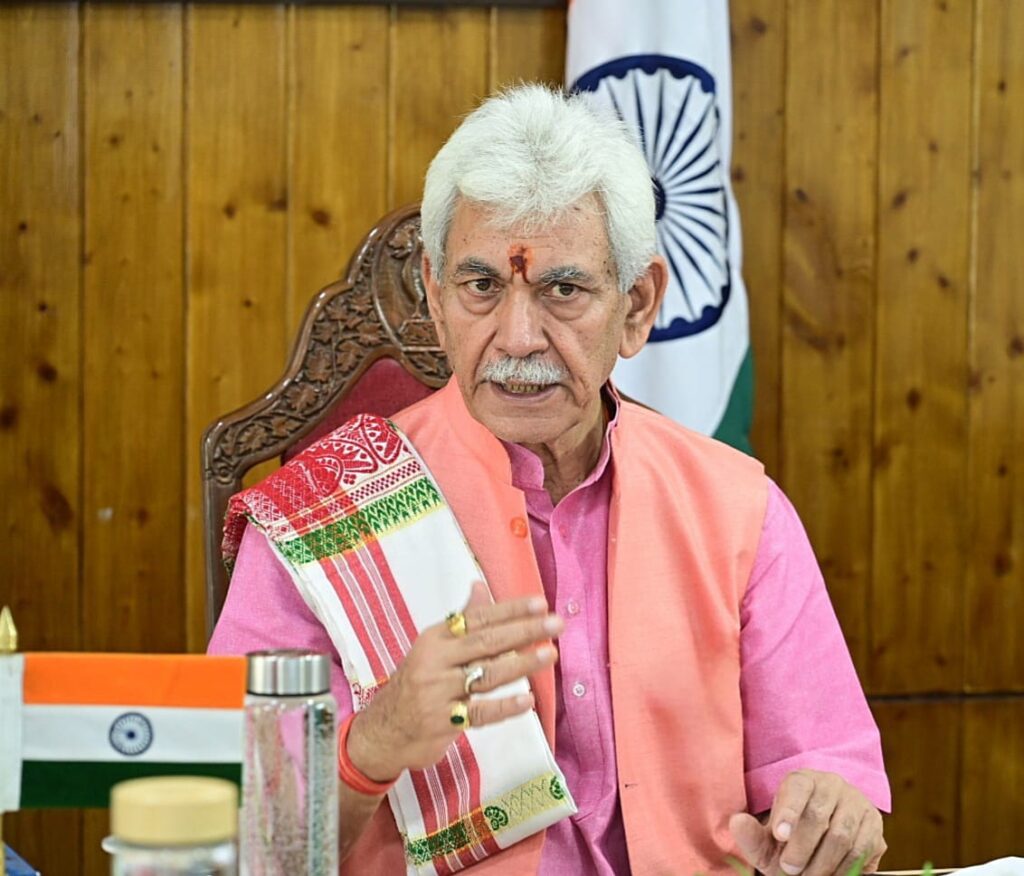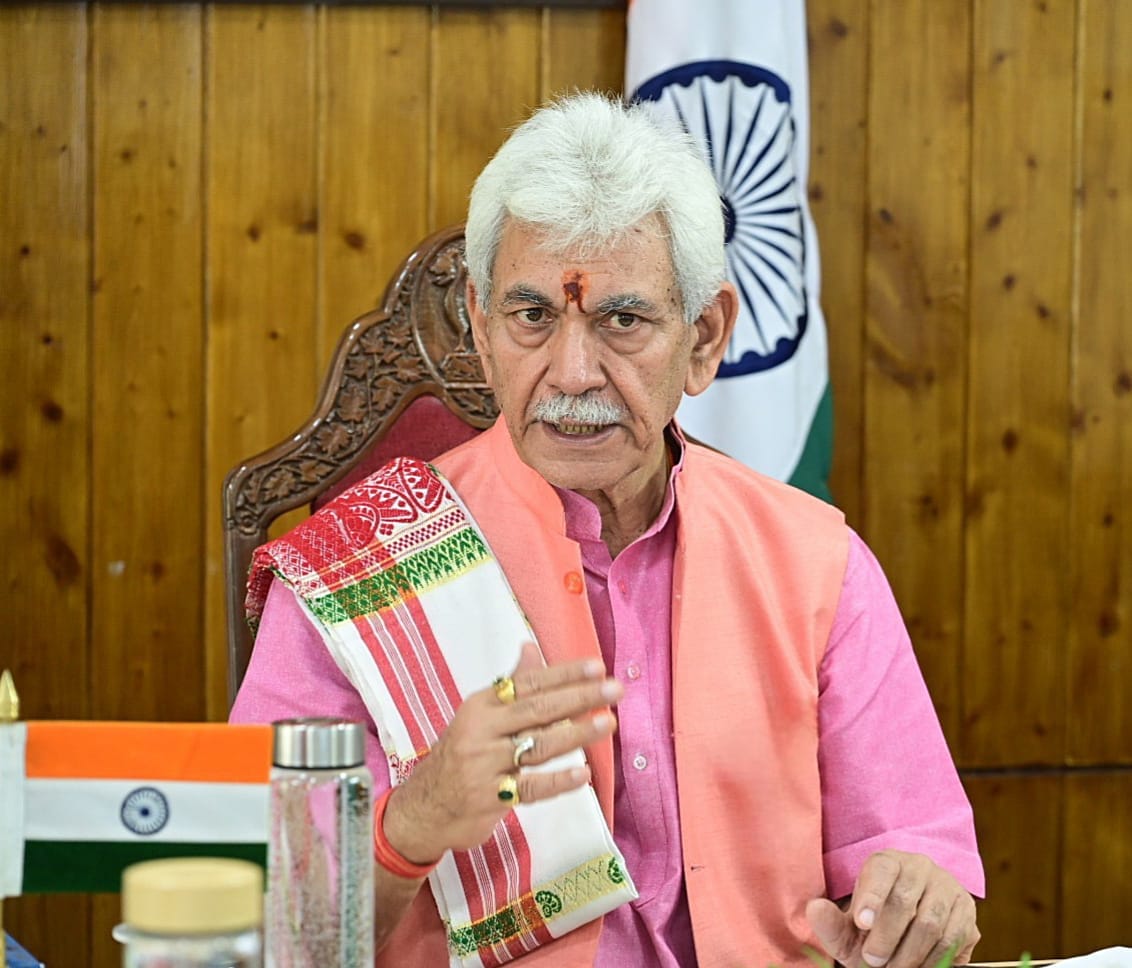By Ajaz Rashid
In an exclusive interview marking nearly five years in office, Lieutenant Governor Manoj Sinha reflects on Kashmir’s remarkable journey from conflict to development
Lieutenant Governor Manoj Sinha’s tenure in Jammu and Kashmir represents one of the most transformative periods in the region’s modern history. Since taking charge on August 7, 2020, in the aftermath of Article 370’s abrogation, the former parliamentarian and engineer has overseen sweeping changes that have redefined daily life in the Union Territory12. As his five-year term draws to a close, Sinha’s reflections reveal both the magnitude of progress achieved and the persistent challenges that continue to shape Kashmir’s future.
The Weight of History and Transformation
Speaking to a national news channel, Sinha acknowledged the historical significance of his tenure while maintaining characteristic humility about its ultimate judgment. “People and history will judge what has changed in five years compared to what used to happen earlier,” he stated, a refrain that underscored his awareness of the transformational journey Jammu and Kashmir has undergone under his stewardship.
The Lieutenant Governor‘s assertion that J&K has “broken away from its troubled past and is embracing a brighter, secure, and development-driven future” reflects a confidence born from tangible changes on the ground. His administration’s approach, as he described it, rested on three fundamental pillars: “Peace, prosperity, and a people-centric approach formed the bedrock of my administration.”
This transformation didn’t occur in a vacuum. When Sinha assumed office, Kashmir was still reeling from the unprecedented communication blackout and security restrictions that followed the August 5, 2019, abrogation of Article 370
Economic Renaissance and Infrastructure Boom
Perhaps the most striking claim in Sinha’s recent interview was his assertion that “J&K’s economy has doubled in the past five years.” This ambitious statement aligns with recent economic data that paints a picture of remarkable recovery and growth. According to the Union Territory’s first Economic Survey since Article 370’s abrogation, J&K’s economy is projected to grow at 7.06% in 2024-25, with nominal GSDP expected to rise by 11.19%67.
The economic turnaround represents a dramatic reversal from the dire predictions that followed the constitutional changes. The region’s GSDP is now estimated at ₹2.65 lakh crore, with per capita income reaching ₹1,54,703 in 2024-25—showing a robust increase of 10.6%68. More encouraging still, unemployment has declined to 6.1% in 2023-24 from 6.7% in 2019-20, reflecting what economists describe as “enhanced employment opportunities and economic dynamism”
This economic revival has been underpinned by an unprecedented infrastructure push. The period from 2019 to 2022 has been characterized as the “golden era of development” in J&K’s history, with the completion of 50,726 projects in 2021-22. Major infrastructure milestones, including the completion of the long-delayed Jehangir Chowk flyover in Srinagar and progress on the world’s highest railway bridge over the Chenab River, have symbolized this transformation.
Return to Normalcy
One of the most visible indicators of transformation has been the return of normal life to Kashmir’s streets. “Stone pelting and hartals are now history. Schools, colleges, and businesses function without disruption, and nightlife has made a comeback,” Sinha observed, pointing to changes that would have been unimaginable just a few years ago.
The revival of nightlife in Kashmir after more than three decades represents perhaps the most symbolic shift. For years, the valley’s evenings were marked by curfews and the fear of violence. Today, restaurants, shops, and entertainment venues remain open late into the night, with illuminated shikaras gliding across Dal Lake like “jewels in the dark”. The reopening of cinema halls, including the inauguration of the first multiplex in Kashmir—Inox in Srinagar—marked another milestone in this cultural renaissance.
Local residents have expressed both relief and optimism about these changes. Maqbool Bhat, a shopkeeper from Srinagar’s old city, captured the sentiment: “Not long ago, the fear and threat that used to prevail with the sunset have disappeared. Terrorists carrying guns and grenades and mobs carrying stones seem to be a thing of the past”
Addressing Historical Wounds
Sinha’s tenure has also been marked by efforts to address long-standing grievances, particularly those of terrorism victims and their families. His emotional recounting of encounters with terror-affected families reveals a more personal dimension to governance. “These meetings moved me deeply, and we took decisions to ensure comprehensive rehabilitation of terror-hit families,” he said, describing a case where a man with three children was killed and only one son received employment assistance.
The Lieutenant Governor admitted that outreach to these families “came late,” but emphasized that his administration has taken steps to reopen old massacre cases, register FIRs, and return properties that may have been seized by terrorists. This acknowledgment of past failures, combined with corrective action, reflects an approach that seeks to heal historical wounds while building trust with affected communities.
Security Challenges and Strategic Responses
Despite the progress, Sinha’s tenure has not been without significant security challenges. The April 22, 2025, Pahalgam terror attack, which claimed 26 lives including tourists and locals, represented the deadliest civilian attack in Kashmir since the 2008 Mumbai attacks. The incident temporarily devastated Kashmir’s recovering tourism industry, with visitor numbers plummeting to as low as 200-400 per day in the immediate aftermath.
However, the government’s response demonstrated both resolve and strategic thinking. India’s retaliatory strikes under “Operation Sindoor” targeted nine terror camps across Pakistan and Pakistan-occupied Kashmir, marking the first time since the 1971 war that all three defense services were used together against Pakistan. “Operation Sindoor showed India’s strength. Pakistan’s fake narratives were exposed. Our indigenous weapons have become a strong asset,” Sinha noted, referring to the precision strikes that eliminated an estimated 80 terrorists.
The operation’s strategic significance extended beyond its immediate military impact. By targeting terror infrastructure while avoiding Pakistani military facilities, India demonstrated what officials called “considerable restraint in the selection of targets and the method of execution”. This calibrated response aimed to deliver a strong message while avoiding escalation—a delicate balance that has characterized India’s approach to cross-border terrorism under the Modi government.
Tourism’s Remarkable Recovery
Perhaps nowhere is the transformation more evident than in Kashmir’s tourism sector. After the Pahalgam attack initially devastated visitor confidence, the industry has shown remarkable resilience. “However, the situation has improved. Over two lakh pilgrims have already participated this year in a 38-day Yatra. Hotels in Pahalgam and Sonamarg are full, and Srinagar’s hotel occupancy is at 40%,” Sinha reported, highlighting the sector’s recovery.
This recovery builds on an already impressive trajectory. Kashmir recorded its highest-ever tourist footfall in 2024, with nearly 2.95 million visitors compared to 2.71 million in 2023. The numbers include a significant increase in foreign tourists, with 43,000 international visitors arriving by December 2024 compared to 37,000 in the previous year. The tourism industry, now the second-largest in Kashmir after horticulture, contributes approximately ₹8,000 crore annually to the local economy.
The government’s multi-pronged approach to tourism recovery has included promotional campaigns involving Bollywood celebrities, social media influencers, and targeted digital outreach.
Women-Led Development
Sinha’s emphasis on women’s empowerment as a driver of regional development reflects both policy priorities and measurable outcomes. “He also hailed the role of women in J&K’s progress, emphasizing their growing leadership across sectors and reaffirming the vision of ‘women-led development’ in the region,” the interview noted.
This focus on women’s empowerment has translated into concrete initiatives. Over seven lakh women have been organized into self-help groups, providing platforms for entrepreneurial development and financial independence. Additionally, around three lakh women farmers have received specialized training, while nearly two lakh agriculture nutrition gardens have been established by women farmers to ensure family food security.
The Lieutenant Governor has consistently emphasized that women are not merely beneficiaries of development but “equal partners in Jammu and Kashmir’s growth journey”. His recent statement that “women-led development will lead us to overcoming challenges like terrorism, drug addiction, and to build a peaceful and prosperous J&K” underscores the administration’s belief in women as agents of social transformation.

Looking Toward the Future
As speculation grows about Sinha’s potential extension for another term, given his administration’s performance across key sectors, his vision for J&K’s future remains grounded in the achievements of the past five years while acknowledging ongoing challenges. “The people of J&K firmly believe their future is secure with India. The only concern remains cross-border infiltration, but rest assured, we are vigilant,” he stated, balancing optimism with realism about security threats.
When asked about his future plans, Sinha reiterated his commitment to “honesty and dedication” while crediting Prime Minister Modi and Union Home Minister Amit Shah for their “guidance and encouragement.” His characterization of their decisions as “historic” for J&K reflects both personal loyalty and recognition of the broader political context that has enabled his administration’s initiatives.
The Measure of Transformation
The question of how history will judge Sinha’s tenure ultimately depends on whether the changes he has overseen prove sustainable and whether they address the deeper aspirations of Kashmir’s people. The statistics paint an impressive picture: economic growth, declining unemployment, record tourism, infrastructure development, and social transformation. The return of normalcy—from functioning schools and businesses to nightlife and cinema halls—represents changes that touch daily life in fundamental ways.
Sinha’s central assertion—that “people and history will judge what has changed in five years compared to what used to happen earlier”—reflects both confidence in his administration’s achievements and humility about their ultimate significance. As his tenure potentially extends into a second term, the Lieutenant Governor’s legacy will depend not just on the transformation he has overseen, but on whether these changes prove durable and whether they address the deeper aspirations of a region that has known too much conflict and too little peace.
